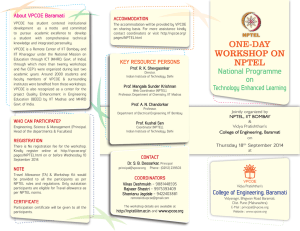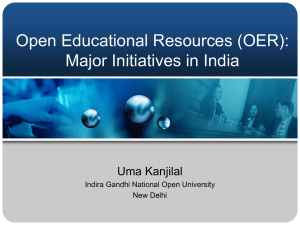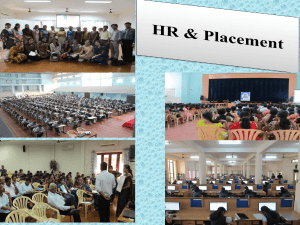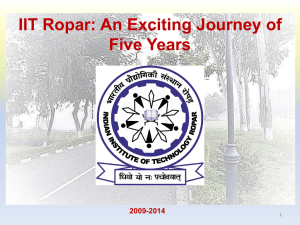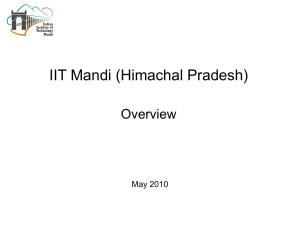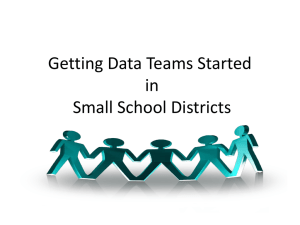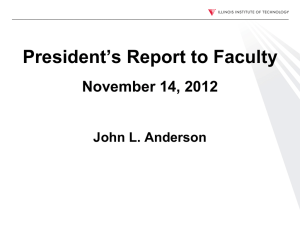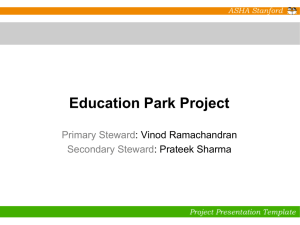NPTEL Phase 2
advertisement
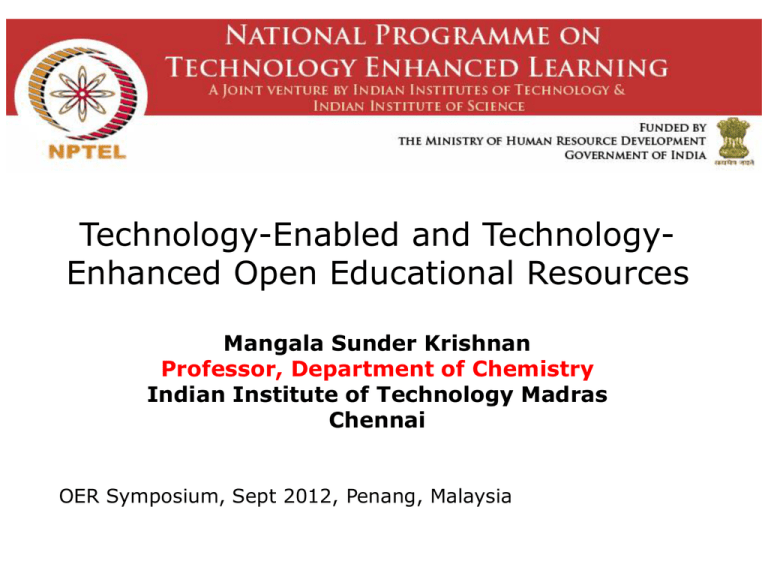
Technology-Enabled and TechnologyEnhanced Open Educational Resources Mangala Sunder Krishnan Professor, Department of Chemistry Indian Institute of Technology Madras Chennai OER Symposium, Sept 2012, Penang, Malaysia To the memory of Prof. Paul Goodman PROFESSOR PAUL S. GOODMAN, Cognitive Psychology, WORLD-RENOWNED PSYCHOLOGIST, RESEARCHER, AUTHOR AND FILMMAKER AT CARNEGIE MELLON National Programme on Technology Enhanced Learning (NPTEL) and National Mission on Education through Information and Communication Technology (NMEICT) Indian Initiatives • NPTEL details of phases I and II/III • User feedback– macro level feedback and a detailed statistical analysis of NPTEL user inputs • Strategies for e-learning and access to large numbers of users—building social, educational networks • NMEICT Current activities • Preliminary details for a virtual University and details of the first phase of the National Mission project known as NMEICT • NPTEL helping School education. • My summary of TEL. National Programme on Technology Enhanced Learning Eight partner Institutes (seven IITs and IISc Bangalore) More than 30 Associate Partner Institutions Professor Bhaskar Ramamurthy, Director, IIT Madras Overall National Coordinator Professor Mangala Sunder, Chemistry Dept. IIT Madras, National Web courses coordinator Professor Kushal Sen, Textiles Department, IIT Delhi, National Video Courses Coordinator Professor M. S. Ananth (Former Director, IIT Madras), Visiting Professor, Dept. of Chemical Engg., IISc Bangalore NPTEL • A joint initiative of IITs and IISc • Dissemination of curriculum-based online Web and Video courses in Engineering, Sciences, Technology, Humanities and Management through open resources • http://nptel.iitm.ac.in NPTEL • Proposal by five IITs and four IIMs in 1999 to the Ministry of HRD for setting up a Virtual Centre for Technology Enhanced Learning (external Partner: Carnegie Mellon U) • Government of India (Ministry of Human Resource Development) sanction to seven IITs (Bombay, Delhi, Guwahati, Kanpur, Kharagpur, Madras and Roorkee) and IISc for developing contents for core curricula in Engineering and core science programmes in 2003 and in 2009 NPTEL • 100 courses in video format and 100 in web based contents proposed in 2003 for three years • (Core sciences, Civil, Electrical, Electronics and Communication, Computer Science and Mechanical Engg.) • 130 in video and 125 in web format made available in 2007 NPTEL • Each course to provide contents for 40 or more one hour lectures to be used in the classrooms of colleges or for private study • Curriculum designed using IIT syllabi and those of major affiliating Universities in India and modularized for adoption. NPTEL Phase 2 – Summary – Branch wise Aerospace Engineering 58 General 1 Architecture 1 Humanities and Social Sciences 72 Atmospheric Science 5 Management 47 Automobile Engineering 2 Mathematics 66 Biotechnology Chemical Engineering 26 100 Mechanical Engineering 102 Metallurgy and Material Science 59 Chemistry and Biochemistry 60 Mining Engineering Civil Engineering 82 Nanotechnology 18 Computer Science and Engineering 47 Ocean Engineering 27 Electrical Engineering 35 Physics 73 Electronics & Communication Engineering 47 Textile Engineering 25 Engineering Design 8 Environmental Science 5 1 Total 967 NPTEL Phase 2 – Syllabus Summary – Institute wise Institute Total IISc Bangalore 97 IIT Bombay 104 IIT Delhi 92 IIT Guwahati 86 IIT Kanpur 180 IIT Kharagpur 135 IIT Madras 199 IIT Roorkee 74 Other Institutions identified as associate partners to the above NPTEL from 2007 onwards • Conversion of all 10300 plus one-hour video lectures so far to streaming and download media (flv, mp4 and 3GP for mobile) format • Uploading all lectures for free video-on-demand access in India and abroad. This is the largest technical video lecture repository on higher education in the world on open access. NPTEL from 2007 onwards • Creation of additional 1000+ courses in all major engg. and science disciplines and some social sciences for both UG and PG level. About 500 of these as 40 one hour courses. Remaining are web based contents. • Detailed syllabi, SME, partners and references finalized for all courses as above. NPTEL Phases II/III (contents to be developed as 4 quadrants, integrated in the final form) Content web based lecture Animations/ visuals / notes / video lectures in an illustrations, video organized form demonstrations/document aries and interactive simulations wherever required Supplementary reading/Wiki Problems, quizzes, Development on the course, assignments and solutions, other resources /open online feedback through content in the internet, Case discussion forums and setting studies, anecdotal up the FAQ information, historical development of the subject NPTEL from 2007 onwards • Partner Institutions other than IITs and IISc for creating course contents • More than 2000 subject matter experts (SMEs) involved • Branch-wise (discipline-wise) expert group constituted and all course titles required for UG curriculum in twenty disciplines assigned to SMEs. NPTEL from 2007 onwards • Course contents to be peer- and user reviewed from time-to-time before being uploaded on the website • User feedback to be incorporated at regular intervals • A social network site (http://www.classle.net) to provide users forum and peer-to-peer and faculty-student interactions online on course contents Accessing NPTEL contents • Video and Web contents from the NPTEL Website http://nptel.iitm.ac.in • Video lecture contents from the YouTube http:// www.youtube.com/iit Devise and guide reforms that will transform India into a strong and vibrant knowledge economy in coming years (all parts of India, that is) Focus areas of interest for the project in several phases Higher Education: Professional Education Distance Education Continuous Learning 4/13/2015 DISTANCE EDUCATION Clear and easily documented need: 1,400,000 engineering seats; 50000 reasonable ones; demand increasing exponentially! Teacher-student ratio around 1:100 for teachers with post-graduate M. S. /M. Tech./Ph. D. qualification 4/13/2015 DISTANCE EDUCATION India has no choice: even to maintain the current levels a new major university needed every week or so! Massive online education is an important emerging market and therefore a business opportunity. 4/13/2015 NPTEL – AN OPPORTUNITY • Technology already available and will only improve. Communications band-width and computer power per unit cost will continue to increase. • NPTEL offers an opportunity to provide reach as well as improvement in quality of the professionals emerging from Universities 4/13/2015 NPTEL – AN OPPORTUNITY • Offers opportunities for crossdisciplinary learning independent of time, geography and social needs for anyone. • Professionals can update themselves while being on the job Users of NPTEL Content (preliminary net survey with about 5000 users in the last few months) Others 1% Faculty 8% Working Professionals 32% Students 59% NPTEL User Classification NPTEL – AN OPPORTUNITY • Technology and reach open up new challenges– Opportunities created by Google, Facebook, YouTube and the Internet extended in the sphere of education and social learning. • Credible partnerships between Academia and the Industry can emerge NPTEL – AN OPPORTUNITY • Professional training and skill building can be effected through learning from NPTEL • NPTEL can provide the certified edupedia for thorough mapping of courses along specific threads– E.g. Google map for routes (Point A to Point B) NPTEL – AN OPPORTUNITY • Good research and social projects executed on a large scale have enormous potential for good business (example: YouTube offering many educational channels for free, http://www.classle.net) NPTEL FAQ http://nptel.iitm.ac.in/faq.php • What is NPTEL? • Why NPTEL? • Is it along the lines of OCW (Open Courseware by Massachusetts Institute of Technology, USA)? • How is NPTEL implemented? • What is there for industries in NPTEL? • What is the current status of the project? • How will NPTEL help the community? • What are the mechanisms for promoting NPTEL? • Who owns the copyrights of the contents of NPTEL ? • How do Institutions and Individuals access these contents? • Can I download these lectures? Current license under CC. • Wherein lies the future? Users of NPTEL Content (~5000 users in the last few months) Others 1% Faculty 8% Working Professionals 32% Students 59% NPTEL User Classification How frequently they refer to NPTEL Courses? Once a week 24% About 3 times a week 28% Atleast twice a month 12% Atleast once a day 36% Purpose of Using NPTEL Content Academic Examinations 34% Compeitive Examinations 29% Interview Preparation 14% Interest in the subject 23% How close is NPTEL course syllabus to their Academic Syllabus? About 50% in common About 80% in common Almost the same syllabus Not much in common 3% 21% 22% 54% Number of NPTEL Courses Accessed 1 Course Between 3 and 5 courses Between 5 and 10 courses More than 1 less than 3 courses more than 10 courses 19% 20% 17% 24% 20% Depth of the subject taught in NPTEL Courses. Very Low 1% Low 1% Medium 12% Very High 37% High 49% Was the explanation sufficient to understand the concepts? Could Not Understand 14% Need some more concepts 23% Able to Understand 17% More than Sufficient 21% Sufficient 25% Quality of NPTEL Course audio, video and text/diagram Not Clear 3% Clear Enough to Learn 29% Very Clear 68% Pace at which the courses were taught? Very Slow 3% Very Fast 6% Slow 7% Fast 29% Average 55% Are users interested to participate in Online NPTEL Discussion forums? No 5% Yes 95% Strategies for effective e-learning • Continued access, easy and just-in-time • Set up social, peer-to-peer and faculty assisted networks and study groups • Encourage interactions and dialogues among learners • Collect continuous, course-specific feedback • Devise strategies for incorporating user feedback in the development process • Bring in partners from industry and research organizations • Continuously upgrade the programme contents and move downward towards school education • Setup online and offline exams and certification as value addon, to enhance employability in core industries NPTEL from 2007—access, from 2011-Social network • Course contents to be peer- and user reviewed from time-to-time before being uploaded on the website • User feedback to be incorporated at regular intervals • A social network site (http://www.classle.net) to provide users forum and peer-to-peer and faculty-student interactions online on course contents Accessing NPTEL • • • • Distribution of courses through Videos Enabling colleges to create their intranet sites Providing mirror site options to partners Running awareness workshops for colleges and students through agencies like Classle and Bodhbridge • AICTE inducing colleges to obtain and use NPTEL contents freely Accessing NPTEL • Running contests for students through Classle • Colleges to nominate students as ambassadors to NPTEL and students interacting with IIT faculty directly • Encouraging college and University faculty to be collaborators and also as SMEs in courses in which they are also experts • Responding quickly to student and teacher queries Classle (http://www.classle.net) as partner • Classle partners with colleges and provides technical assistance in web set up • Classle interacts with industry (mainly IT at present) and encourages professionals to contribute to its content libraries • Classle encourages (on-ramp) content development like YouTube and allows them to upload (peer review happens after the contents are loaded) • Classle offers all of these free on-demand. NPTEL and the National Mission • The National Mission on Education Through Information and Communication Technology (NMEICT) • Launched by MHRD, Government of India with a budget allocation of Rs. 4612 crores (approximately USD $ 1 billion) • URL: http://www.sakshat.ac.in Mission: Provide •High quality educational, training and open research content online and free of charge to every citizen •High speed connectivity so that India-Internet thrives, ideas exchange and dialogues and interactions lead to growth NMEICT (Mission) • Design and develop low, inexpensive connecting devices, support their research to ensure everyone has means to access and participate in knowledge creation. • Derive similar programmes in school education and enable education to meaningful and rich experience rather than promote rote information. NMEICT (Mission) • A proper balance between content generation, research in critical areas relating to provide best education • Connectivity and • integration of our knowledge with the world pool To be achieved through several phases of the mission. Creating Digital-Learning Environment for Design in India – ‘e-kalpa’: 4 National Mission in Education through ICT February 2012 Digital-learning environment for Design 4 Key Themes: ‘e-kalpa’ Focus Areas 1. Digital online content for learning Design with distance e-Learning programs on Design Achievements so far: Setting up of the webspace ‘Dsource.in’ for access to content along with studio with equipment and support staff at each of the partner Institutes 3. Digital Design Resource Database Documentation of resources in terms including the craft sector of process, methodology, case studios to create content undertaken at the partner Institutes 2. Social networking for Higher Experimenting with the webspace Learning with collaborative Learning ‘Dsquare.in’ for access to content Space for Design for Synchronous and along with studio and support staff at Asynchronous Interaction each of the partner Institutes 4. Design inputs for products of Support is being to other initiatives National Mission in Education through of NMICT – Jellow, Sakshat website + ICT Identity, logo, naming, etc. 1. Digital online content for learning 2. Digital Design Resources 3. Networking for learning 4. NMEICT support Digital-learning environment for Design Deliverables: Expected Completed Deliverables till now for the Project Feb 2012 i. Design Courses 40 Courses 40 Courses ii. Full resource documentation of fine examples of Design, crafts and arts + Workshops with Experts iii. Video Lectures of eminent designers 40 Topics 50 topics 25 Lectures 25 lectures iv. Case Studies of good design projects 70 Case Studies 70 Case Studies by professions and students v. Documentation of design process from around the country each in 12 images x12 words 150 topics 200 topics Digital-learning environment for Design Deliverables by March 2012: Expected Completed Deliverables till now for the Project Feb 2012 Additional by March 2012 i. Design Courses 40 Courses 40 Courses 20 Courses ii. Full resource documentation of fine examples of Design, crafts and arts + Workshops with Experts iii. Video Lectures of eminent designers 40 Topics 50 Topics 20 Topics 25 Lectures 25 Lectures 10 Lectures iv. Case Studies of good design projects 70 Case Studies 70 Case Studies 25 Case Studies by professions and students v. Documentation of design process from around the country each in 12 images x12 words 150 topics 200 topics 100 topics Virtual Labs A Project headed by IIT Delhi and funded by the MHRD • Coordinator: Prof. Ranjan Bose, Department of Electrical Engineering, IIT Delhi • Concept note originally proposed by Professor Surendra Prasad, Director, IIT Delhi (20052011) • The following slides were provided by the VL team in IIT Delhi. I am grateful to the team. The basic idea Remote User 1 Remote User 2 Internet Physical Lab (located remotely) Remote User n Objectives of the Virtual Lab Project • To provide remote-access to labs in various disciplines of Science and Engineering. To cater to students at the UG level, PG level as well as to research scholars. To enable the students to learn at their own pace, and to arouse their curiosity. To provide a complete Learning Management System that includes webresources, video-lectures, animated demonstrations and self evaluation. Types of Virtual Labs Remote Triggered Measurement Based Modeling / Simulation Based Intended Users • College Students who do not have access to good lab-facilities. High-school students, whose inquisitiveness will be triggered, possibly motivating them to take up higher-studies. • Researchers in different institutes who can collaborate / share equipment and resources. Different engineering colleges, who can benefit from the content and related teaching resources. Participating Institutes • IIT Delhi IIT Guwahati • IIT Bombay IIIIT Hyderabad • IIT Kanpur Amrita University • IIT Kharagpur Dayalbagh University • IIT Madras NIT Karnataka • IIT Roorkee COE Pune Broad Areas for Virtual Labs • • • • • • • • • Electronics and Communication Engineering Computer Science and Engineering Electrical Engineering Mechanical Engineering Civil Engineering Chemical Engineering Biomedical and Biotechnology Engineering Chemical Sciences Physical Sciences All areas of Science and Engineering are covered Website: www.vlab.co.in One common website to access all Virtual Labs Content • Pedagogy and organization for individual Universities and autonomous Institutions • Prof. Anup K. Ray Arbitrary Home Page of a Course Website Course Name : Control Systems Course ID : Institute : Department : EE 302/10-11 XYZ Institute of Technology Electrical Engineering Overview Objectives C M Case Studies C M U Summary M U Projects M U Form Groups Add Comments Take Notes Add Resources Abbreviations : C : Course A : Audio C M Ask Question FAQs C References Resources A V Txt Assignment U C M U Self Assessment C M Simulation Virtual Labs M: Module U : Units V : Video Txt :Text U Technology Enhanced Learning • Promote critical thinking (enhancement) • Visualization and visualizability of concepts (enhancement) • Demonstration and hands-on experience (enable) • Integration of teaching and learning in synchronization with the environment of the child/student/adult/all-time learners (enable) • Mass education and lack of physical infrastructure and teachers (enable) • Building competitiveness, and think out-of-the-box at an early age • Building a Nation to its fullest capacity– a nation as large as India, with one sixth of the world’s population Solve all problems in India and solutions for everyone else also emerge! Thank You.
